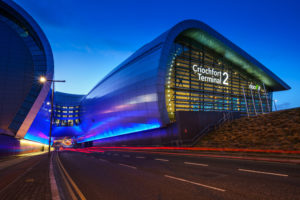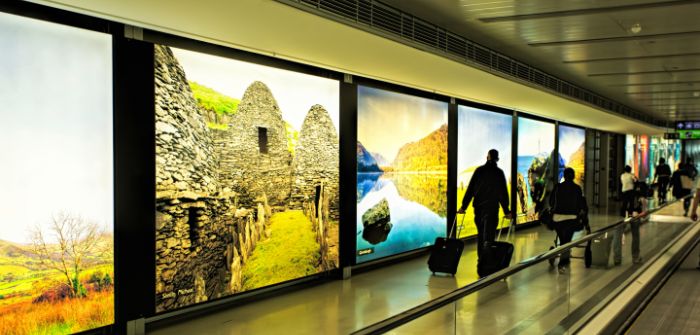Visitors to Day 1 of Passenger Terminal Conference 2019, held in London on March 26-28, listened as Jan Richards, head of insights and planning at Dublin Airport, described airports as a microcosm of society. PTW speaks exclusively to Richards to find out more.

What is your role at Dublin Airport?
I am head of insights and planning, which is a new role that was formed about five years ago in response to increasing customer-focused services at the airport.
I focus on improving the passenger research we carry out and then using that research to undertake work around the passenger experience, journey mapping and understanding how the passenger feels. I work cross functionally across the airport to improve the whole experience.
My role ultimately covers passenger experience, brand planning and research. We’ve started measuring the voices of the employee as well as the customer, and we try to connect things to form a dashboard with some kind of correlation between the feedback.
How do you get the insights?
We have a research program which has two main quantitative trackers – one is passenger tracking. We’re interviewing passengers face-to-face on an almost 24/7 basis – we speak to more than 20,000 a year. It’s a seven- to eight-minute interview but we get an awful lot out of that: we know who they are, their age, reason for travel, destination, what services they’re using, and so on, which helps us understand the changing demographic, how people’s purpose of travel is changing, and the different services they’re using.
We then have the customer satisfaction monitor and that’s upward of 8,000 face-to-face interviews a year that tell us about passenger satisfaction levels for services along most of the journey. We also do a lot of qualitative focus groups as well.
How important is an independent airport brand?
We know from our research that the most important thing for airports is destination and price. Price is something that we’re not in control of – that’s an airline decision – but the business-to-business marketing of an airport is definitely an important department because an airport is capable of bringing in airlines and helping build destinations.
 One important part of our research is onward connections, so we know where passengers are connecting to and we can highlight for our sales department when people are regularly connecting onward to a particular destination, so we can start offering a direct service.
One important part of our research is onward connections, so we know where passengers are connecting to and we can highlight for our sales department when people are regularly connecting onward to a particular destination, so we can start offering a direct service.
Many airports are focusing on the transfer market as more people are flying and are happy to transfer to get somewhere – it doesn’t put people off like it used to. The transfer market is a market in its own right – people will transfer via somewhere and remember it’s a great airport to transfer via, so they’ll chose it again. If you’re a monopoly airport, branding might be less important, but in London, for example, there are Heathrow, Gatwick and City, and I could choose any of those – the experience and the brand is important in making me choose that airport again.
At Dublin, our reputation is crucial, as we’re the flagship airport for Ireland. We’re the first point of welcome so we have to be a great brand and offer a great experience – we’re representing the island of Ireland. I think a brand is crucial for an airport, but it depends on which market you’re targeting and how important you are to the business of the country you’re in.
What are the main things that Dublin’s brand encompasses?
We represent Ireland, but if you’re a transfer passenger you need to be able to see Ireland without leaving the airport. Our people and our service at the airport also have to express the welcome that the Irish are known for. That makes the whole human side of the experience even more important for us – ‘Irishness’ is very important but defining that is a deep well that isn’t worth jumping into!
So, we’ve tried to define what we think the airport can do to represent Irishness – warmth and ingenuity. We make sure our staff understand the warm welcome and importance of customer service, and we have really high scores on courtesy and helpfulness.
What are some of the challenges faced by Dublin Airport?
Speed of growth – we were the fastest growing airport in Europe for several years. Another challenge is capacity; we’ve had to quite quickly add capacity – stands, buildings, and so on – which is difficult. Trying to maintain high levels of customer satisfaction while you have all the building work going on is also a challenge.
For the first time, I’ve been involved in capital planning at the airport so that there is somebody thinking about the passenger and their experience. We’ve used a passenger experience agency for the first time as part of the infrastructure planning process, which has been really good.
We’re adding remote stands, remote boarding gates, etc, which presents challenges that can make the passenger experience more difficult. We monitor our ease score, our reputation and our brand score. The ACI ASQ score is really important to us, and throughout all the developments in the past three years we’ve managed to retain our Top 5 ASQ score in our competitive group (15m+ group) and Top 10 in European airports.
How have you used passenger insights to influence services or technologies introduced into the airport?
Another part of my job is looking at passenger trends and one of the big things we’ve seen is the move toward comfort. We know that one of the most important areas of an airport is departure gates and people spend a fair amount of time here, so one of the key things is the comfort of the seating. We worked with Asset Care to make sure all of the seats at gates have soft cushioning as opposed to metal seats and our customer satisfaction scores went through the roof. We’ve also introduced water fountains and reusable cups as passengers no longer want to buy single-use plastic bottles.
We started direct routes to China and, following research from Chinese passengers, have begun offering hot water and Chinese signage in line with their needs. The increase in solo passengers means we’ve started making sure there are more two-seater areas rather than the normal four-seater tables.
Shopping is becoming less important at airports but what is becoming important is airports as a place for entertainment rather than just for passing through, so we’re examining the whole F&B offer to make sure we are providing somewhere people can get a great quality and range of food in line with their needs. We’ve found we need a mix of local and international food and beverage, and we try and balance that mix carefully.
We’ve just started making our own honey as part of our sustainability projects – we’ve got an apiary and have just produced a batch. We had a competition among staff to give it a name and it is called Nect-Air. We use that in our lounges, it’s a tiny thing but it is important.
What will the airport of the future look like?
I think it will segment more – there are the bits people don’t want to be bothered with like check-in and security, and they have to become seamless and effortless and offer an easy passenger experience. And they don’t necessarily need to have staff at them unless there is a problem.
But then there’s the other side of things where there are passengers who are less used to traveling that need more help and a human face. Ever greater service will be expected. I think that airports could fall into the trap of throwing technology at stuff when actually there will always be that balance needed between the human face and technology.
And then there’s the question of what an airport is – is it just somewhere for people to travel through quickly or will it become a place where we can meet and enjoy entertainment? I think airports will be one or the other – either fast-track lanes or places for people to spend time.
What advice would you give to other airports looking to stand out from the crowd?
I think it isn’t just about travel trends, you have to understand trends and the way that people’s behavior is changing. You need to understand the differences in generations, and in the medium term it is about service and the human touch.
My one piece of advice would be understanding the way the environment and world events are affecting the way we travel. The second thing would be knowing what your airport is trying to do – you need a very clear brand strategy. Knowing your identity and what you’re giving to your passengers is key.

